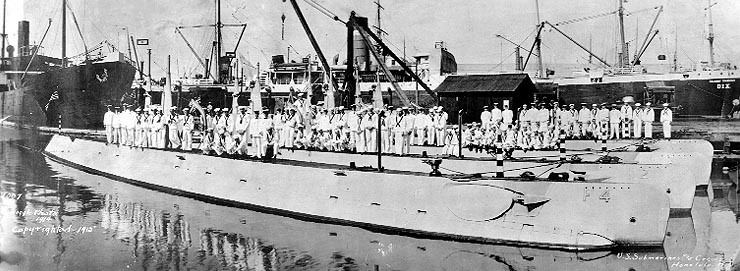Name F class Built 1911-1912 | ||
 | ||
Builders Electric Boat (design)Union Iron WorksMoran Bros. | ||
The F-class submarines were a group of four submarines designed for the United States Navy by Electric Boat in 1909. F-1 and F-2 were built by Union Iron Works in San Francisco, while F-3 and F-4 were built by Moran Bros. in Seattle, Washington.
Contents
Design
They were generally similar to the C-class and D-class submarines built by Electric Boat, but larger at 400 tons submerged vs. 337 tons for the D class. They were single-hulled boats with circular sections laid along the longitudinal axis. Overall length was 142 feet 6 inches (43.43 m) and the beam was 15 feet 5 inches (4.70 m). The E-class and the F-class submarines were the first US submarines to have bow planes. Like the E class, their early-model diesels had problems and were replaced in 1915.
The hull contained three compartments:
The two diesel engines were clutched to shafts that turned electric motors that could also be used as generators for charging the batteries. The shafts also turned the screws. For submerged operation, the diesels were de-clutched and shut down, with the battery providing all of the submarine's power. The battery was an array of cells in rubber-lined, open-topped, steel jars.
These vessels included some features intended to increase underwater speed that were standard on US submarines of this era, including a small sail and a rotating cap over the torpedo tube muzzles. For extended surface runs, the small sail was augmented with a temporary piping-and-canvas structure. Apparently the "crash dive" concept had not yet been thought of, as this would take considerable time to deploy and dismantle. This remained standard through the N class, commissioned 1917-1918. Experience in World War I showed that this was inadequate in the North Atlantic weather, and earlier submarines serving overseas in that war (E class through L class) had their bridge structures augmented with a "chariot" shield on the front of the bridge. However, as the F class served in the Pacific, they did not receive this upgrade. Starting with the N class, built with lessons learned from overseas experience, US submarines had bridges more suited to surfaced operations in rough weather. The streamlined, rotating torpedo tube muzzle cap eliminated the drag that muzzle holes would otherwise cause. In the stowed position, the submarine appears to have no torpedo tubes, as the holes in the cap are covered by the bow stem. This feature remained standard through the K class, after which it was replaced with shutters that were standard through the 1950s.
History
All four F-class submarines spent their careers in the Pacific Fleet, primarily based in San Pedro, Los Angeles, California with a stint in Hawaii. F-4 was lost off Hawaii on 25 March 1915 due to a battery acid leak corroding the hull. F-1 and F-3 collided off San Diego on 17 December 1917, and F-1 was lost. F-2 and F-3 survived to be decommissioned and scrapped in 1922 to comply with the limits of the Washington Naval Treaty.
